Feathers are flying over a rock crusher’s plans for a Glen Rose landmark.
By Story and photos BY JEFF PRINCE
Chalk Mountain’s name is accurate in one respect: Pick up most any rock lying around and you’re ready to write on the blackboard. The “mountain” part, however, is no more accurate than it would be for any of the modest, scenic hills around Glen Rose, about an hour’s drive southwest of Fort Worth.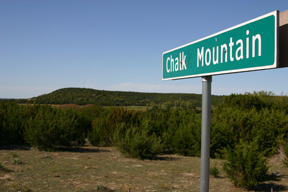
U.S. 67 cuts right through the area, through Somervell and Erath counties. To the west of the highway, maps designate one particular hill that looks like an upside-down ice cream cone as Chalk Mountain, but locals use the name more generally, to refer to the whole range of hills, to the pioneer settlement that sprang up there in the 1800s and the ghost town that remains, and to the new development of houses spreading among the vistas and valleys. For bird watchers, the name Chalk Mountain refers to a little holy land – the nesting place for two rare birds listed among the federal government’s top-10 endangered species.
For most of those who live there, Chalk Mountain means a way of life, a pure, simple, daily reminder of why they settled in this part of the state. Arrowheads, still found among the hills, provide a link to the Indian tribes who once lived there, and the abundant fossils hint at the land as it was before any humans existed. The hills are a breathtaking gateway to Glen Rose for motorists entering from the west on U.S. 67, and a roadside park built in 1958 gives passersby an opportunity to pull over, chill out, and absorb the view.
“Chalk Mountain stands so tall, and you can see it for miles and miles around,” said local historian JoAnn Smyth.
In truth, the “mountain” would have to stand on tiptoe to stretch past 1,000 feet or so. But the hills help set Somervell County apart from the rest of the North Texas rolling prairie, putting it at the center of what’s sometimes called the North Texas Hill Country.
The Chalk Mountain hills are privately owned by an assortment of people, some new to the area, some with roots stretching back generations. Some purchased five or 10 acres and built dream homes with panoramic views. Some bought working cattle ranches. Others turned longtime ranches into safe havens for wildlife, particularly for two species of rare birds – the golden-cheeked warbler and the black-capped vireo. 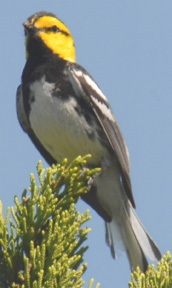 So it’s no surprise that people went ballistic after a company applied for a permit to begin mining 250 acres of a hillside directly across from the roadside park and amid the birds’ nesting area.
So it’s no surprise that people went ballistic after a company applied for a permit to begin mining 250 acres of a hillside directly across from the roadside park and amid the birds’ nesting area.
“We’re supposed to be stewards of the land; obviously, some of us aren’t,” said Glen Rose resident Sally Cassady.
This time around, the locals aren’t fighting some giant corporation. They’re fighting a Stephenville landowner and a Brownwood businessman who says his rock crushing company consists mainly of himself and his son.
“All we want to do is make a living,” said Tommy Davis, owner of Slick Machines of Brownwood. “It’s a small operation. These people are making a big to-do over nothing.”
A small operation it may be, but it’s basically strip-mining, which means trees and any other ground cover will be scraped off and a slice of Chalk Mountain blasted away and turned into gravel, leaving an ugly scar on the hillside. Locals compare it to knocking the nose off Lincoln’s face on Mount Rushmore.
Chalk Mountain isn’t a national monument, however, and opponents are floundering when it comes to halting the destruction. Texas is business-friendly. Property rights are valued. The Texas Commission on Environmental Quality (TCEQ) appears poised to issue an air-quality permit allowing the rock crushing to begin.
During an emotional meeting last week, one local politician seeking re-election dangled the possibility of establishing a conservation easement that might save the hillside, but it was a stretch. Legally, there is little anyone can do to stop the rock crusher and landowner from exercising their right to exploit the minerals.
“Everything is in their favor except public opinion,” said Darrell Best, a nearby homeowner. “We hate to see Chalk Mountain taken down. Once it’s down, we’ll be looking at a pit for generations. There are lots of places to get gravel. Getting it from a historic place like Chalk Mountain is hard to take.”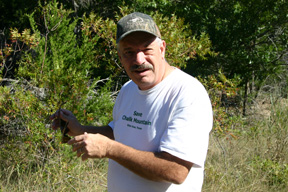
About 50 locals with banners saying “Save Chalk Mountain” gathered at the U.S. 67 roadside park just a few miles outside of Glen Rose on a recent Saturday. Their mission: Gaze at the hillside, grouse about plans to turn it into a gravel pit, and fire up troops to attend a public meeting with TCEQ representatives seeking input on Davis’ application for the rock crushing permit.
The 250 acres designated for mining represent a small percentage of Chalk Mountain land, but it’s high-profile acreage – visible from the park and to U.S. 67 motorists heading in or out of Glen Rose. The rock crushing machine might as well be smashing these locals’ collective hearts.
“We watch the sun set over that mountain,” nearby homeowner Jeannie Lane said.
“He’s not being a good neighbor,” Joan Echols Taylor of the nonprofit Somervell History Foundation said about landowner Larry Parham.
The group gladly offered myriad reasons why a gravel pit is a bad idea. They fear mining will destroy historic artifacts from Native Americans who lived in these hills, whose stone tools the locals are still finding. Dinosaur tracks have been spotted in the area. The nearby Fossil Rim Wildlife Center and Dinosaur Valley State Park are popular tourist attractions.
Then there’s the expected increase in heavy-truck traffic on the winding, hilly, and already-dangerous U.S. 67. They worry that dust will drift off-site and cover trees and homes and contribute to residents’ asthma problems. They fret about reduced property values and the effect on tourism and, therefore, the local economy. They wonder if blasting will crack the foundations on nearby homes or ruin water wells. They agonize that carving out a chunk of mountain will change water runoff patterns and flood their properties or send silt running into creeks.
They’re cranky about an out-of-town landowner and an out-of-town rock miner exploiting a cherished landmark – with little or none of the money staying in the county. Once the mining is finished, nobody has jurisdiction to require reclamation to be done. The hillside could remain scarred for ages.
“Once you grind all that up, you can’t get it back,” another nearby homeowner, Steve Allen, said. “The first thing you’ll see when you cross the county line is an ugly gravel pit.”
Davis had pretty much refused to talk to locals about his plans. Parham, likewise, was silent, even though his family hails from the area and has owned part of Chalk Mountain for many years.
“He’s not interested in talking to us,” said Best, one of the most vocal activists.
Davis hasn’t been idle. By law, he can clear trees, begin blasting, and do just about any sort of preparation he deems necessary while waiting for state approval to move the heavy rock crushing equipment to the site. A small portion of Parham’s land – about an acre of low-lying property barely visible to passersby – was already scarred. Parham’s family had allowed Somervell County to scrape for surface rock back in the 1950s. In the past few weeks, Davis had been busy with prep work, and the scar had expanded to about five acres.
“They’re already destroying the rocks and trees, and he’s already disturbed the natural part,” Taylor said. “It’s going to look like a dust bowl.”
Contacted by Fort Worth Weekly, Davis said he wasn’t interested in allowing a reporter on-site, but he agreed to a phone interview. He doesn’t appear to be losing much sleep over the growing resentment he hears in the community. While he waits for his permit, he’s improving the private road to the site, sorting and piling loose rock to be crushed, and clearing trees from several acres in preparation for a long-term mining operation.
“It will be here for the next 30 or 50 years,” Davis said. A permit would allow him to remove up to 75,000 tons of rock a year, five days a week, 30 weeks a year.
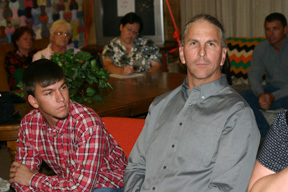
One person’s lemon is another’s lemonade. Davis sees nothing but the benefits of the operation. His company will make money, and construction outfits and natural gas drillers will get the gravel they need to build roads and pad sites. Parham will earn income from his property by leasing his mineral rights. And while some lament a portion of mountain being dynamited, crushed, and hauled off, the operation might ultimately increase the property’s value – it’s easier to build houses on a filled-in gravel pit than on steep hillsides. And new homeowners would have great views of whatever’s left of Chalk Mountain.
As hills go, Chalk Mountain’s rolling landscapes don’t necessarily stand out as anything extraordinary. But they are home sweet home to possums, armadillos, coyotes, and other animals – most significantly, the two endangered species of birds that migrate here each year to roost, nest, and raise chicks before heading to Mexico for the winter.
“See the dark greens and the light greens mixed together there?” said Lee Clauser, pointing toward the tree-covered hillsides. “The dark green is old-growth cedar. The light green is oak.”
That’s the perfect combination of trees in an ideal terrain for the golden-cheeked warbler. Of the state’s more than 350 species of birds, the warbler is the only one that nests exclusively in Texas. Warblers restrict themselves to about 30 counties in central Texas. The birds peel away thin strips of bark from the old cedars, carry them to the tops of oak trees, and combine the soft bark with spider webs to build nests.
Black-capped vireos, on the other hand, are attracted to the small, shrubby shin oaks and sumac trees rampant on Chalk Mountain. Both species’ habitat has shrunk over the years. Many old-growth cedar ranges have fallen to the march of commercial and residential development. And rare now are the range fires that once kept shin oaks and sumacs low to the ground and ideal for black-capped vireos. As a result, both birds have been on the endangered list for about 20 years.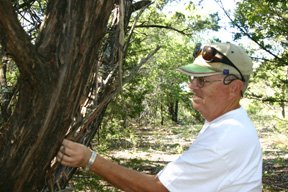
From February to July, Clauser leads bird tours on private ranches managed as wildlife reserves. Property owners around Chalk Mountain formed a wildlife association with 55 members and a combined 65,000 acres. In exchange for property tax exemptions, they groom and maintain their land to provide a natural refuge for wildlife. More than $745,000 in federal grants have gone to pay for maintenance, and the association has used controlled burns and mowing to keep the sumacs and shin oaks low to the ground for scrub-loving vireos. They’ve preserved and encouraged the thick stands of old cedars and oaks, installed birdhouses along fence lines, and set traps for predator birds that kill warbler chicks.
A licensed bird rehabilitator, Clauser has cared for a red-tailed hawk named Lady for the past 26 years and takes her to schools and churches for presentations. His Chalk Mountain tours attract birders from across the United States and even Europe. He guides them through the woods and knows the best spots for observing birds. Many people get their first glimpses of warblers and vireos at Chalk Mountain – and turn Clauser into a people-watcher as well as a birder.
A devoted birder glimpsing his first vireo or warbler is like a kid’s first trip to a candy store. “I enjoy watching the people – they get really excited,” Clauser said.
“It’s almost guaranteed during that three-month nesting period that the birders will see both of those species” at Chalk Mountain, said Jim Jones, a board member with the Audubon Society’s Fort Worth chapter. “We have done field trips there every year.”
Birders enjoy hiking, photographing nature, or just sitting for long spells and watching the songbirds. Chalk Mountain has been a safe haven, while the already-small nesting territory for these birds has continued to shrink elsewhere. Removing another 250 acres of prime nesting area, particularly one that abuts a wildlife association’s carefully maintained habitat, can’t help.
Clauser and Lady were a popular attraction at the roadside park rally. He ended up with the hawk after federal wildlife agents confiscated her from a poacher who had illegally captured the chick and was trying to sell her at a flea market.
A retired banker, Clauser lives about three miles from the proposed gravel pit. He won’t be able to see the rock crushing from his living room, like some others, but he’s as upset as anyone. He bought his 116 acres about 20 years ago and built a 2,100-square-foot house there in 2000. He built an aviary for Lady, large enough to allow her to fly around. Clauser and other homesteaders came to this part of the country for the elbow room, natural beauty, clean air, and vivid views.
Davis doesn’t see what all the fuss is about. Parham’s 250 acres is a small percentage of the total Chalk Mountain range. Everyone is expecting the worst before he’s even done anything, Davis said. If he gets his permit, he predicted, he probably won’t mine anywhere near the maximum allowed 75,000 tons. His crew consists mainly of himself and his son, Trey, he said.
He gets disgusted with Clauser and the other protesters. “They’re hypocrites is what they are,” he said. “How many of them have their properties leased for gas wells? They can lease their property mineral rights for gas but Mr. Parham can’t lease his mineral rights for rock?”
Most surrounding property owners did lease their mineral rights to natural gas drillers when the Barnett Shale phenomenon hit a few years ago. Clauser makes an interesting case study. He bought his property “back when land was cheap enough to buy” and built his house to take advantage of the views. Later, he leased his mineral rights to a gas driller and used the money to build a large barn and workshop. The gas company never drilled, however, and the lease ran out. Clauser got a payday and a barn and didn’t even have to endure a noisy gas derrick and a three-acre pad site carved out of his land. Still, he’d made it possible.
Clauser is a talented guy – he has built several glider planes and is a licensed glider pilot. In addition to carving out a homestead and courting gas drillers, he built a 40-foot-wide, 2,700-foot-long runway.
“How do we know the bird [Clauser] is complaining about wasn’t affected by his runway?” Davis said.
Clauser sees at least one big difference.
“I don’t have the habitat he has,” he said. “I wish I did, and [then] you would not have seen a runway down the middle of my place.” Clauser bought a played-out, overgrazed old ranch with few trees. While he’s built the runway and outbuildings, he’s also restored the natural grasses and planted numerous trees.
“The land is much better today with the grasses on it than it was when I purchased it,” he said.
Other homesteaders have cut down trees to make way for houses, but they’ve replanted trees and improved their sites in most cases. Leases with gas companies were generally signed only when reclamation was promised.
“We manage our land, we don’t destroy it,” Clauser said. “I can’t say he is managing his land. That scar is getting worse and worse.”
Protesters say they aren’t against entrepreneurship, property rights, or gravel pits. But there is a line between progress and defacement of a historic piece of land, Clauser said.
“We’re not against rock crushers – I’ve got a rock house and a driveway made of caliche rock – but we feel there are other places [to get gravel] that don’t have the endangered species on them,” he said.
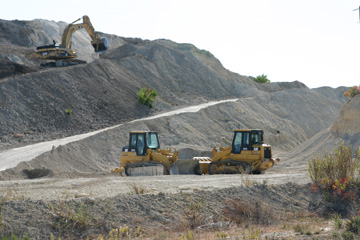
One of the wildlife association’s members is Charles Brown, a wildlife biologist who owns 321 acres of what used to be a cattle ranch. While much of the sprawling 65,000-acre wildlife area is somewhat distant from the proposed gravel site, Brown’s land is directly adjacent – he and Parham share a half-mile of fence. A dusty and noisy mining operation on Parham’s side of the hill will scare away birds that nest there and probably spook the ones on Brown’s property as well, he said.
“If they start taking down the old-growth cedar and oak canopies on the tops and sides of those mountain, they could disturb the habitat for both of those species,” Brown said.
His angst is widely shared. About 250 people crammed into a Glen Rose citizen center last Thursday night for the public meeting with Davis and the state environmental agency. Afterward, some protesters felt their first bit of optimism.
Davis arrived at the meeting looking spiffy. His long hair was braided into a ponytail that hung to his waist. He wore dress shoes, slacks, and a button-down shirt. He sat upright in a chair facing the large crowd, chin up, and showed no signs of being intimidated by a posse of pissed-off people. His son Trey sat next to him. They watched for almost three hours as, one by one, local residents questioned the appropriateness of a Chalk Mountain gravel pit.
One young woman cried as she recalled family outings to the hills over the years. “That’s our mountain!” she said, inciting a round of applause from the crowd.
Davis has little tolerance for comments like that. He respects Brown for what he’s done for the habitat on Chalk Mountain and has been willing to share information with the biologist since they share a fence line and Brown has been civil during previous discussions. But Davis considers most others to be sticking their noses into somebody else’s business.
Still, he was stoic during the meeting. Only once did he roll his eyes. The crowd applauded almost every speaker who questioned the gravel pit, and even Davis applauded several times. He didn’t speak, though. He’d hired Hill Country Environmental Inc., a firm that represents companies dealing with environmental regulations, to help him wade through the local, state, and federal rules and secure permits. One of Hill Country’s representatives took questions.
During a break, I asked Davis why he didn’t take the opportunity to speak to the crowd and let them get to know him. “This isn’t my thing,” he said. “I’m a miner.”
The crowd later razzed State Rep. Sid Miller after the Republican from Stephenville said he was serving only as a resource and facilitator on the problem, not as a proponent of one side or the other. The crowd wasn’t buying it. They wanted advocacy and vowed to remember their representative’s waffling on election day. Then Miller introduced a possibility that pricked up their ears: creation of a conservation easement, an agreement between the landowner and conservationists, with financial benefits for the landowner.
“That would be the best win-win situation we could come out of this with,” Brown said.
In a conservation easement, Parham theoretically could agree to stop mining in exchange for payments that Miller said could come from any number of potential donors – conservation groups, surrounding property owners, foundations, municipalities, and other sources.
Parham and Miller met earlier this week to talk more.
“I went through the numbers on it, about what he could expect to receive over the lifetime of that rock crusher, and we could match that through a conservation easement,” the legislator said. He figured Parham might earn close to $200,000 in five years of mining rock if he produced the maximum 75,000 tons a year. “I’m going to keep working this angle as long as I can and see if I can make it come to fruition,” he said.
“The only thing that would stop them is if we can come to a compromise with this conservation easement,” Miller said. “It’s a long way from a done deal.”
Still, it was a glimmer of hope, and one that Brown was willing to hold onto.
“Everybody would leave happy,” Brown said. “Whether or not the details can be worked out in a timely manner is another issue. Putting a conservation easement in place can get complicated.”
Everything seemed complicated to the crowd at the TCEQ meeting. The permitting process can take months, and yet the miner can begin clearing land during the waiting process, dynamiting, sifting through and sizing rock for sale, and doing just about anything else except using a rock crusher to create gravel. Once he gets the permit, the chance of stringent state controls on dust and other potential problems seems slim. If dust drifts onto other properties, owners who want something done must notify TCEQ in Austin, which has 30 days to send an investigator. Proving where the dust came from wouldn’t be easy.
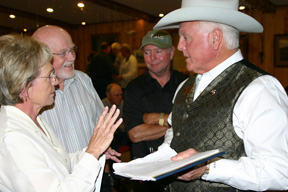 Glen Rose resident Jennifer Miller is a former TCEQ investigator and knows how easy it is for miners to get permits and how cumbersome it can be for adjoining property owners to stop a rock crusher.
Glen Rose resident Jennifer Miller is a former TCEQ investigator and knows how easy it is for miners to get permits and how cumbersome it can be for adjoining property owners to stop a rock crusher.“The TCEQ’s hands are tied in terms of what they are allowed to do by law in terms of denying an application,” she said.
A TCEQ representative told the crowd that a small percentage of permit applications are contested, and only a small percentage of those are denied. The “vast majority” of applicants receive a permit, the representative said, to groans. Violators usually get multiple warnings and plenty of chances to remedy problems before any penalties are levied.
“The people’s hands are tied,” Miller said. “It’s such a long, tedious process to actually get anything done.”
A TCEQ rep drew applause when she said that unified resistance to a permit application sometimes causes landowners to drop their requests. With that and the idea of the conservation easement, the crowd filed out of the meeting with some glimmer of newfound hope.
Many weren’t aware that Parham had been sitting in the crowd, soaking in everything. At the end of the evening, when most people had gone home, Brown, Clauser, and few others hung around, hoping to glean fresh information from Davis, who was genial if guarded. Once the building was closed, Davis and Parham stood talking in the parking lot for a moment.
Some applicants might drop permit requests in the face of opposition, but he won’t, Parham said. The more venom cast his way, the more inclined he is to forge ahead.
“I have a problem with people trying to tell me what I can do with my own property,” he said.
Sure enough, Miller and Parham’s discussions about a conservation easement broke down this week. “He turned us down, and he says any amount of money wouldn’t get him to change his mind,” Miller said.
The legislator said he will write TCEQ and ask them to deny the permit.
“Having exhausted all of my other avenues of pursuit, I don’t have any other chioce than to stand up for the community,” he said – for all the good it’s likely to do.






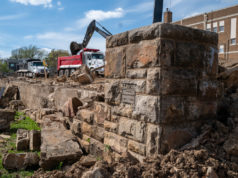





[…] Grinding Up Chalk Mountain – Of the state’s more than 350 species of birds … Most surrounding property owners did lease their mineral rights to natural gas drillers when the Barnett Shale phenomenon hit a few years ago. Clauser makes an interesting case study. […]